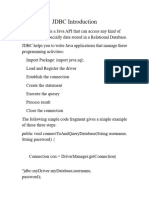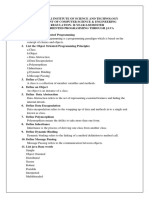0% found this document useful (0 votes)
31 views12 pagesJDBC Notes
Java Database Connectivity (JDBC) is an API that enables Java applications to interact with various databases by executing SQL queries and retrieving results. It consists of key components such as JDBC drivers, DriverManager, and the JDBC API, which facilitate database connections and operations. The document outlines the architecture, benefits, and steps to establish a JDBC connection, along with example code for connecting to MySQL and Oracle databases.
Uploaded by
sreeee437Copyright
© © All Rights Reserved
We take content rights seriously. If you suspect this is your content, claim it here.
Available Formats
Download as PDF, TXT or read online on Scribd
0% found this document useful (0 votes)
31 views12 pagesJDBC Notes
Java Database Connectivity (JDBC) is an API that enables Java applications to interact with various databases by executing SQL queries and retrieving results. It consists of key components such as JDBC drivers, DriverManager, and the JDBC API, which facilitate database connections and operations. The document outlines the architecture, benefits, and steps to establish a JDBC connection, along with example code for connecting to MySQL and Oracle databases.
Uploaded by
sreeee437Copyright
© © All Rights Reserved
We take content rights seriously. If you suspect this is your content, claim it here.
Available Formats
Download as PDF, TXT or read online on Scribd
/ 12






















































































